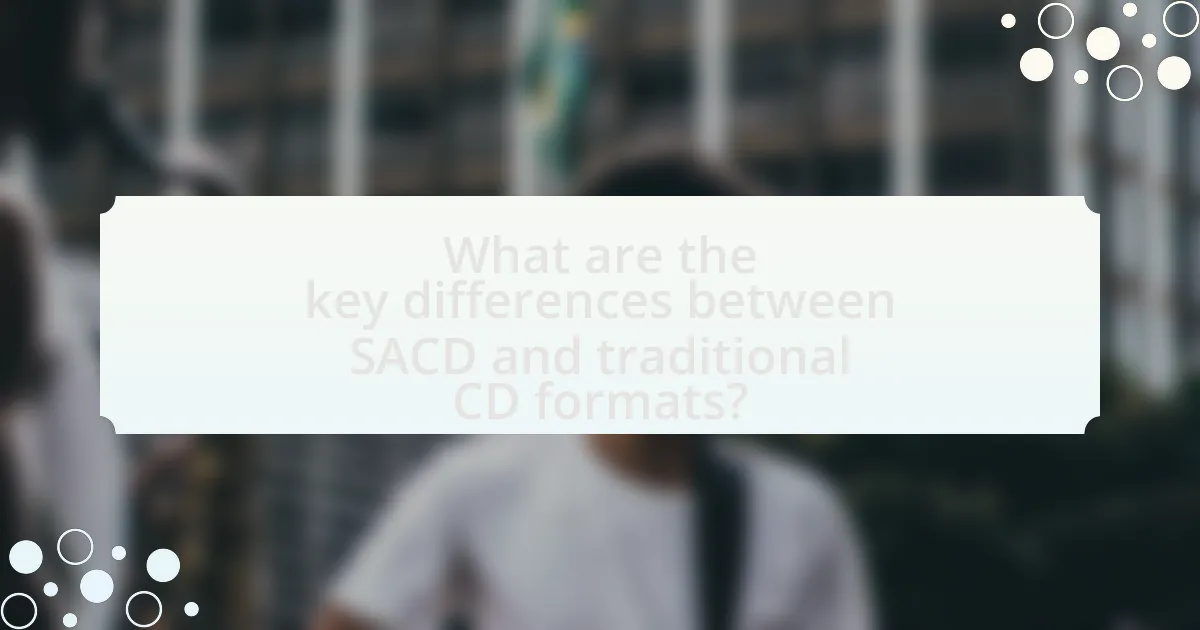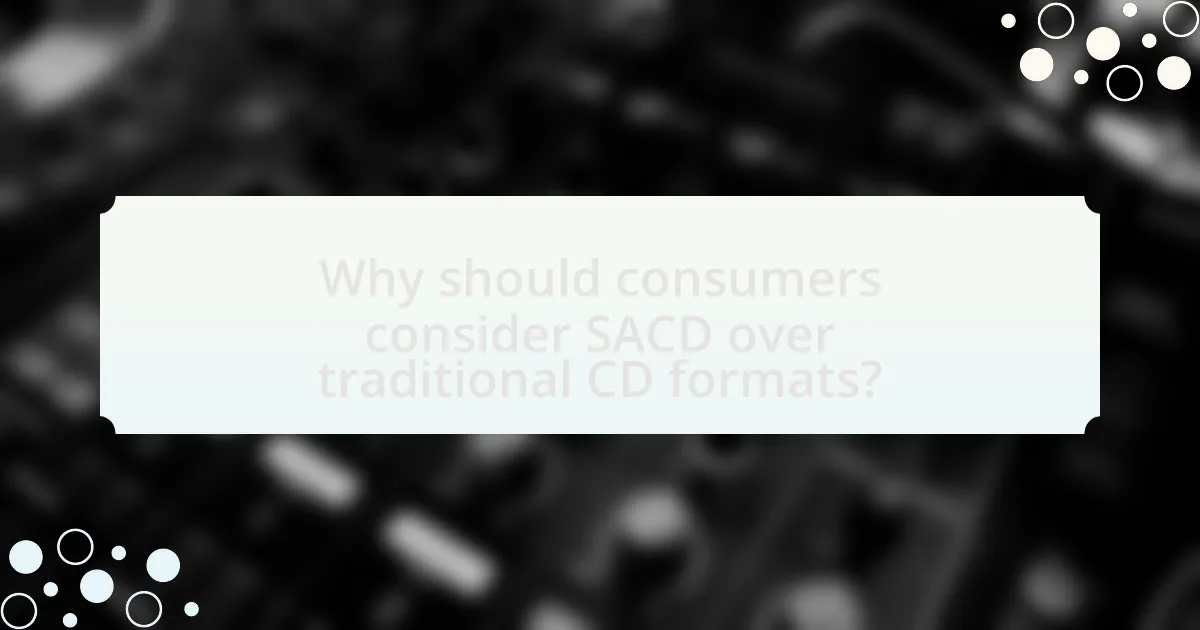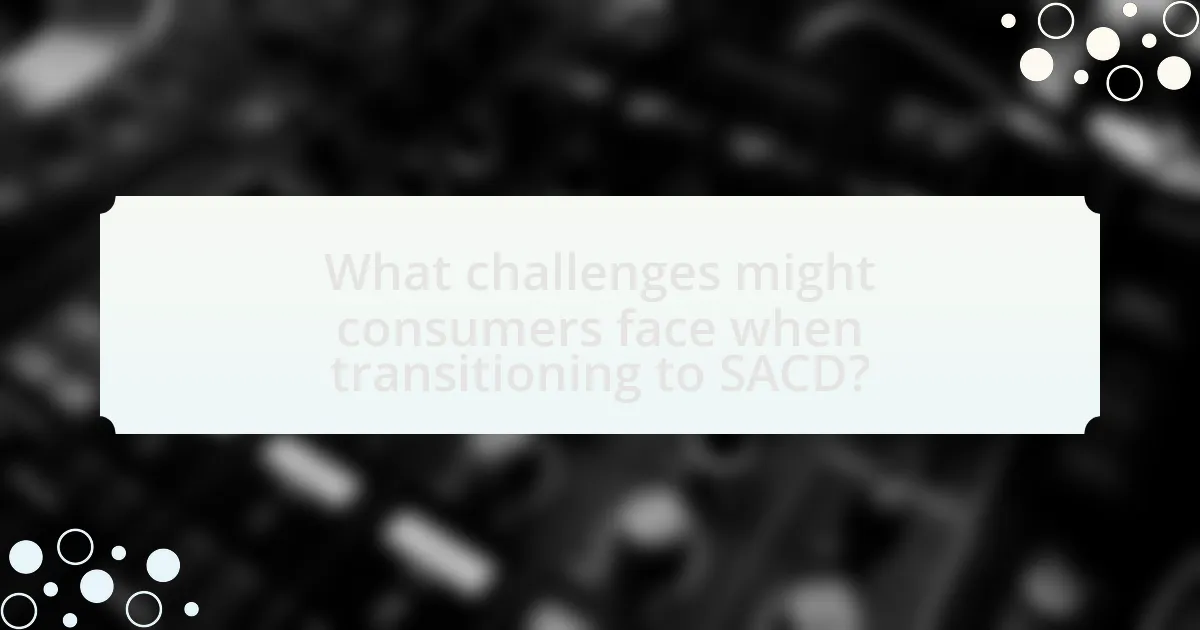The article focuses on the benefits of Super Audio CD (SACD) over traditional CD formats, highlighting key differences in audio quality and storage capacity. SACD utilizes a higher sampling rate and Direct Stream Digital (DSD) encoding, resulting in superior sound reproduction and the ability to support multi-channel audio. The article discusses how these technical specifications enhance the listening experience, the advantages of SACD’s larger storage capacity, and the types of content it can accommodate that traditional CDs cannot. Additionally, it addresses consumer considerations, including compatibility issues, the evolving market for SACD, and practical tips for maximizing the SACD experience.
What are the key differences between SACD and traditional CD formats?

The key differences between SACD and traditional CD formats are primarily in audio quality and storage capacity. SACD, or Super Audio CD, utilizes a higher sampling rate of 2.8224 MHz and a different encoding method called Direct Stream Digital (DSD), which allows for a more detailed and dynamic sound compared to the standard CD’s 44.1 kHz PCM format. Additionally, SACDs can store more audio data, accommodating multi-channel audio and higher resolution stereo tracks, while traditional CDs are limited to stereo sound and a maximum of 700 MB of data. These technical specifications contribute to SACD’s ability to deliver superior sound quality, making it a preferred choice for audiophiles.
How does SACD enhance audio quality compared to traditional CDs?
SACD enhances audio quality compared to traditional CDs by utilizing a higher sampling rate and bit depth, which allows for greater detail and dynamic range in sound reproduction. Specifically, SACD employs Direct Stream Digital (DSD) encoding with a sampling rate of 2.8224 MHz, significantly surpassing the 44.1 kHz sampling rate of standard CDs. This increased resolution results in a more accurate and immersive listening experience, capturing nuances in music that traditional CDs cannot. Additionally, SACD supports multi-channel audio, providing a surround sound experience that further enriches the audio quality.
What technical specifications contribute to SACD’s superior sound quality?
SACD’s superior sound quality is primarily attributed to its use of Direct Stream Digital (DSD) encoding, which operates at a higher sampling rate of 2.8224 MHz compared to the 44.1 kHz of traditional CDs. This high sampling rate allows for a more accurate representation of audio signals, resulting in greater detail and clarity in sound reproduction. Additionally, SACDs utilize a 1-bit audio format, which minimizes quantization errors and enhances dynamic range. The multi-channel capability of SACD also contributes to a more immersive listening experience, allowing for surround sound configurations that traditional CDs do not support. These technical specifications collectively ensure that SACD delivers a richer and more nuanced audio experience.
How does the multi-channel capability of SACD impact the listening experience?
The multi-channel capability of SACD significantly enhances the listening experience by providing a more immersive sound environment. This format allows for audio to be distributed across multiple channels, typically five or more, which creates a three-dimensional soundstage that traditional stereo CDs cannot replicate. Research indicates that listeners often perceive greater depth and clarity in music when experienced through multi-channel audio, as it enables distinct placement of instruments and vocals within the sound field. This spatial arrangement leads to a more engaging and realistic auditory experience, making SACD a preferred choice for audiophiles seeking superior sound quality.
What are the advantages of SACD’s storage capacity over traditional CDs?
SACD’s storage capacity significantly exceeds that of traditional CDs, allowing for more audio data to be stored. Specifically, a standard SACD can hold up to 6.4 gigabytes of data, compared to the 700 megabytes of a standard CD. This increased capacity enables SACDs to deliver higher resolution audio formats, such as DSD (Direct Stream Digital), which provides a more detailed and dynamic sound experience. Additionally, the larger storage allows for multi-channel audio, enhancing the listening experience with surround sound capabilities that traditional CDs cannot offer.
How does increased storage capacity affect audio fidelity?
Increased storage capacity enhances audio fidelity by allowing for higher resolution audio formats and more detailed sound reproduction. For instance, Super Audio CDs (SACDs) can store up to six times more data than traditional CDs, enabling the use of DSD (Direct Stream Digital) encoding, which captures audio with greater detail and dynamic range. This increased data capacity results in a more accurate representation of the original sound, leading to improved clarity and depth in audio playback. Studies have shown that listeners can perceive significant differences in sound quality when comparing high-resolution audio formats to standard CD quality, reinforcing the benefits of greater storage capacity in achieving superior audio fidelity.
What types of content can be stored on SACDs that traditional CDs cannot accommodate?
SACDs can store high-resolution audio formats, including DSD (Direct Stream Digital) and multi-channel audio, which traditional CDs cannot accommodate. Traditional CDs are limited to standard resolution PCM (Pulse Code Modulation) stereo audio, typically at 16-bit/44.1 kHz. In contrast, SACDs support up to 24-bit/192 kHz audio and can include up to six channels of audio, allowing for a more immersive listening experience. This capability is due to the SACD’s use of a different disc structure and encoding method, which enables the storage of larger amounts of data compared to standard CDs.
Why should consumers consider SACD over traditional CD formats?

Consumers should consider SACD over traditional CD formats primarily for its superior audio quality. SACD, or Super Audio CD, utilizes a higher sampling rate and bit depth, allowing for a more detailed and dynamic sound reproduction compared to standard CDs. Specifically, SACDs can deliver audio at a resolution of up to 5.6 MHz in DSD (Direct Stream Digital) format, while traditional CDs are limited to 44.1 kHz and 16-bit PCM. This enhanced resolution results in a more immersive listening experience, capturing nuances in music that standard CDs cannot reproduce. Additionally, SACDs often include multi-channel audio options, providing a surround sound experience that further enhances the listening experience.
What are the long-term benefits of investing in SACD technology?
Investing in SACD technology offers long-term benefits such as superior audio quality, enhanced durability, and increased market value for music collections. SACD, or Super Audio CD, utilizes a higher sampling rate and bit depth compared to traditional CDs, resulting in a more accurate and immersive sound experience. This technology supports multi-channel audio, allowing for a richer listening experience that appeals to audiophiles. Additionally, SACDs are less prone to physical wear and tear due to their robust design, ensuring longevity in playback quality. The growing interest in high-resolution audio formats also suggests that SACD collections may appreciate in value over time, making them a worthwhile investment for music enthusiasts.
How does SACD contribute to a more immersive listening experience?
SACD contributes to a more immersive listening experience by utilizing high-resolution audio formats that provide greater detail and clarity compared to traditional CDs. This format supports multi-channel audio, allowing for surround sound configurations that enhance spatial awareness and depth in music playback. Studies have shown that SACD can deliver audio quality up to 6.1 MHz, significantly surpassing the 44.1 kHz of standard CDs, resulting in a richer and more engaging listening experience.
What are the potential cost savings associated with SACD in the long run?
The potential cost savings associated with SACD in the long run include reduced production costs and lower distribution expenses. SACD’s ability to store high-resolution audio and multiple channels on a single disc minimizes the need for multiple formats, which can lead to savings in manufacturing and inventory management. Additionally, SACD’s durability compared to traditional CDs can result in fewer returns and replacements, further decreasing costs over time. Studies indicate that the longevity of SACD can lead to a decrease in overall lifecycle costs, making it a financially advantageous option for both producers and consumers.
How does the availability of SACD titles compare to traditional CDs?
The availability of SACD titles is significantly lower than that of traditional CDs. While traditional CDs have a vast catalog with millions of titles across various genres, SACDs are limited to a few thousand titles, primarily focusing on classical, jazz, and select popular music. This disparity is due to the niche market for SACDs, which has not achieved the same widespread adoption as CDs since their introduction in the early 2000s. Consequently, consumers seeking SACD titles often encounter challenges in finding a diverse selection compared to the extensive offerings available for traditional CDs.
What genres or artists are more likely to release music on SACD?
Genres more likely to release music on SACD include classical, jazz, and high-fidelity rock. Artists such as Telarc, Deutsche Grammophon, and Blue Note frequently utilize SACD for its superior audio quality. The SACD format supports multi-channel audio and higher resolution, making it particularly appealing for genres that benefit from intricate soundscapes and dynamic range, such as orchestral and live recordings. This trend is supported by the fact that many audiophile labels prioritize SACD to enhance the listening experience for discerning audiences.
How does the market for SACD evolve in relation to traditional CDs?
The market for SACD has evolved to occupy a niche position compared to traditional CDs, primarily due to its superior audio quality and multi-channel capabilities. While traditional CDs have dominated the music market since their introduction, SACDs have attracted audiophiles seeking enhanced sound experiences, leading to a gradual but steady increase in SACD sales since their launch in 1999. According to the Recording Industry Association of America, SACD sales have remained limited, with estimates suggesting that they represent less than 1% of total physical music sales, indicating that while SACDs have carved out a dedicated audience, they have not significantly displaced traditional CDs in the broader market.
What challenges might consumers face when transitioning to SACD?

Consumers may face several challenges when transitioning to SACD, including compatibility issues with existing audio equipment. Many standard CD players do not support SACD playback, necessitating the purchase of a new player that can handle the format. Additionally, the availability of SACD titles is limited compared to traditional CDs, which can restrict consumers’ choices in music. Furthermore, the higher cost of SACD discs and players can be a financial barrier for some consumers. These challenges can hinder the adoption of SACD despite its superior audio quality.
How can consumers overcome compatibility issues with SACD players?
Consumers can overcome compatibility issues with SACD players by ensuring they use compatible equipment and formats. Many SACD players are designed to play standard CDs, but not all players support the hybrid SACD format, which contains both SACD and CD layers. To address this, consumers should check the specifications of their SACD player to confirm it supports the desired formats. Additionally, using a receiver or amplifier that has HDMI or multi-channel inputs can enhance compatibility, as many SACD players output high-resolution audio through these connections. Furthermore, consumers can consider purchasing a universal player that supports various formats, including SACD, DVD-Audio, and standard CDs, to maximize their playback options.
What types of players are required to fully utilize SACD’s features?
To fully utilize SACD’s features, players specifically designed for SACD playback are required, such as dedicated SACD players or universal disc players that support SACD formats. These players are engineered to read the high-density data of SACDs, which allows for superior audio quality and multi-channel sound capabilities compared to traditional CD players. SACD players utilize a different laser technology and decoding methods to access the DSD (Direct Stream Digital) audio format, which is essential for delivering the enhanced sound experience that SACDs offer.
How can consumers ensure their existing audio equipment supports SACD playback?
Consumers can ensure their existing audio equipment supports SACD playback by checking for specific features such as SACD compatibility, which is typically indicated on the device or in the user manual. Many SACD players also support standard CD playback, so verifying that the equipment can read hybrid discs, which contain both SACD and CD layers, is essential. Additionally, consumers should look for digital outputs like HDMI or multi-channel analog outputs, as these are often required for optimal SACD performance. According to the specifications provided by manufacturers, devices labeled as “SACD compatible” or “SACD player” will confirm their ability to play SACDs.
What are the common misconceptions about SACD that consumers should be aware of?
Common misconceptions about SACD include the belief that it is only beneficial for classical music, that it requires specialized equipment to enjoy, and that it offers no significant audio improvement over standard CDs. While SACD does excel in classical music due to its high-resolution audio capabilities, it also enhances genres like jazz and rock. Additionally, while high-quality playback equipment can maximize the SACD experience, many standard players can still decode SACD formats. Finally, studies have shown that SACD provides a noticeable improvement in sound quality, particularly in dynamic range and clarity, compared to traditional CDs, making it a valuable format for audiophiles across various music styles.
How does the perception of SACD’s complexity affect consumer adoption?
The perception of SACD’s complexity negatively affects consumer adoption by creating barriers to understanding and usage. Many potential users view SACD as a complicated format due to its advanced features, such as multi-channel audio and high-resolution sound, which can deter them from making a purchase. Research indicates that consumers are more likely to adopt technology that they perceive as user-friendly; for instance, a study by the Consumer Electronics Association found that 70% of consumers prefer simpler audio formats. This suggests that the intricate nature of SACD may lead to lower adoption rates compared to traditional CD formats, which are widely recognized and understood.
What myths about SACD’s sound quality should be clarified?
Myths about SACD’s sound quality that should be clarified include the belief that SACD inherently sounds better than traditional CDs. While SACD offers higher resolution audio, the actual sound quality depends on various factors such as the recording quality and playback equipment. Additionally, some people think that all SACDs provide a significant improvement over CDs; however, this is not always the case, as some SACDs may not utilize their full potential. Furthermore, the myth that SACD is only beneficial for classical music ignores its advantages across various genres, as many modern recordings also benefit from SACD’s capabilities.
What practical tips can help consumers maximize their SACD experience?
To maximize the SACD experience, consumers should invest in a high-quality SACD player and compatible audio equipment. A dedicated SACD player can decode the high-resolution audio formats that standard CD players cannot, ensuring optimal sound quality. Additionally, using a surround sound system or high-fidelity stereo setup enhances the immersive audio experience that SACDs provide.
Consumers should also select high-quality SACD titles, as the benefits of SACD are most pronounced in well-produced recordings. Listening in a quiet environment further allows for the nuances of the high-resolution audio to be appreciated. Finally, utilizing proper speaker placement and room acoustics can significantly improve sound clarity and depth, making the most of the SACD format’s capabilities.
How can consumers select the best SACD titles for their collection?
Consumers can select the best SACD titles for their collection by focusing on critically acclaimed albums, genre preferences, and audio quality. Notable SACD releases often include remastered versions of classic albums, which enhance sound fidelity, making them a worthwhile addition. Additionally, exploring reviews from audiophile communities and music publications can guide consumers toward high-quality titles. For instance, albums like “Dark Side of the Moon” by Pink Floyd and “Bach: The Well-Tempered Clavier” by Glenn Gould are frequently recommended for their superior sound quality on SACD.
What setup recommendations enhance the SACD listening experience?
To enhance the SACD listening experience, it is recommended to use a dedicated SACD player that supports high-resolution audio formats. A high-quality DAC (Digital-to-Analog Converter) can further improve sound fidelity, as SACDs often contain more audio detail than standard CDs. Additionally, utilizing a well-calibrated audio system with high-quality speakers and proper room acoustics will optimize sound reproduction. Research indicates that the combination of these elements significantly elevates the listening experience, allowing listeners to fully appreciate the superior audio quality that SACDs offer compared to traditional CD formats.

Leave a Reply